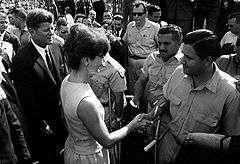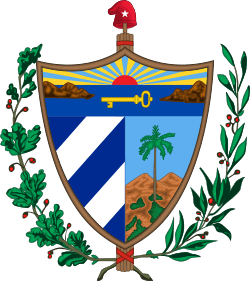Brigade 2506
Brigade 2506 (Brigada Asalto 2506) was the name given to a CIA-sponsored group of Cuban exiles formed in 1960 to attempt the military overthrow of the Cuban government headed by Fidel Castro. It carried out the abortive Bay of Pigs Invasion landings in Cuba on 17 April 1961.
| Brigade 2506 | |
|---|---|
 | |
| Active | May 1960 – December 1962 |
| Country | |
| Allegiance | CIA |
| Type | State-sponsored Paramilitary organization |
| Role | Guerrilla warfare |
| Size | 1,511 |
| Garrison/HQ | JMTrax, Guatemala |
| Patron | |
| Motto(s) | Overthrow Fidel Castro |
| Engagements | Bay of Pigs Invasion |
| Insignia | |
| Brigade flag |  |
History
In May 1960, the CIA began to recruit anti-Castro Cuban exiles in the Miami area. For most recruits, infantry training was carried out at a CIA-run base code-named JMTrax near Retalhuleu in the Sierra Madre on the Pacific coast of Guatemala.
In November 1960, with Gregorio Aguilar Matteo spearheading training with 430 men, the leaders were chosen and the group was named Brigade 2506. It was also known as the Blindado Battalion among members, using the membership number of Carlos (Carlyle) Rafael Santana Estevez, who had died in a training accident in September 1960.[1] The principal commanders were appointed as follows:[2][3]
- Manuel Francisco Artime Buesa: political leader
- José Alfredo 'Pepe' Pérez San Román: military commander
- Erneido Andrés Oliva Gonzalez: military second-in-command
- Manuel Villafaña Martinez: commander of the air force
- Alejandro del Valle Martí: 1st paratroop battalion
- Hugo Sueiro Ríos: 2nd infantry battalion
- Noelio Montero Díaz: 3rd battalion
- Valentín 'Pipo' Bacallao Ponte: 4th armoured battalion
- Ricardo Montero Duque: 5th infantry battalion
- Francisco Montiel (Maciera) Rivera: 6th infantry battalion
- Roberto Pérez San Román: heavy gun battalion
- Ramón J. Ferrer Mena: chief of staff
- Enrique Ruiz Williams
- Higinio Nino Díaz
- Francisco Perez Castro "Brillo" Infantry battalion

About 1,334 men traveled on a seaborne force from Guatemala, of which about 1,297 actually landed in Cuba, plus an additional 177 airborne paratroops. An estimated 114 drowned or were killed in action, and 1,183 were captured, tried and imprisoned. Private sympathizers in the United States eventually negotiated to give $53 million worth of food and medicine in exchange for release and repatriation of Brigade prisoners to Miami starting on 23 December 1962. On 29 December 1962, President John F. Kennedy hosted a 'welcome back' ceremony for captured Brigade 2506 veterans at the Orange Bowl in Miami. Some of its members have gone on to found the Brigade 2506 Veteran's Association, which controls the Bay of Pigs Museum & Library in Miami.[4][5][6][7][8]
References
- Johnson, Haynes. 1964, 1974. The Bay of Pigs: The Leaders' Story of Brigade 2506. W.W. Norton & Co Inc. New York. ISBN 0-393-04263-4, p. 47
- Thomas, Hugh. 1971, 1986. The Cuban Revolution. Weidenfeld and Nicolson. London. (Shortened version of Cuba: The Pursuit of Freedom, includes all history 1952–1970) ISBN 0-297-79037-4 ISBN 0-297-78954-6, p. 581
- Fernandez, Jose Ramon. 2001. Playa Giron/Bay of Pigs: Washington's First Military Defeat in the Americas. Pathfinder ISBN 0-87348-925-X ISBN 9780873489256, p. 101
- Susan Candiotti & Garrick Utley (2001-04-17). "Exiles' passion still high 40 years after Bay of Pigs". CNN.
- Susan Candiotti & Garrick Utley (2001-04-17). "Remembering the Bay of Pigs invasion". CNN.
- Oscar Corral (2006-04-20). "Bay of Pigs vets have put their loss in perspective". Seattle Times.
- "The Return of Brigade 2506". Time Magazine. January 4, 1963.
- Thomas (1971)
- "The Negotiator". News & Information. www.cia.gov. Feature Story Archive. Washington, D.C.: Central Intelligence Agency. June 16, 2017. Retrieved July 25, 2017.
- Wyden, Peter: Bay of Pigs - The Untold Story. Simon and Schuster. New York 1979, ISBN 0-671-24006-4 ISBN 0224017543 ISBN 978-0-671-24006-6.
